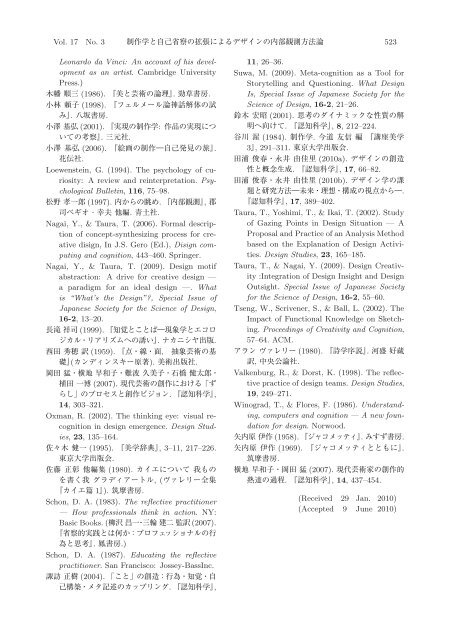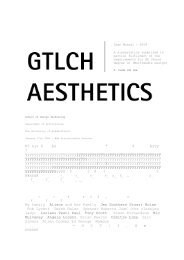paper-nagai-taura-sano
paper-nagai-taura-sano
paper-nagai-taura-sano
Create successful ePaper yourself
Turn your PDF publications into a flip-book with our unique Google optimized e-Paper software.
Vol. 17 No. 3 523<br />
Leonardo da Vinci: An account of his development<br />
as an artist. Cambridge University<br />
Press.)<br />
(1986). . .<br />
(1998). <br />
. .<br />
(2001). : <br />
. .<br />
(2006). .<br />
.<br />
Loewenstein, G. (1994). The psychology of curiosity:<br />
A review and reinterpretation. Psychological<br />
Bulletin, 116, 75–98.<br />
(1997). . , <br />
. .<br />
Nagai, Y., & Taura, T. (2006). Formal description<br />
of concept-synthesizing process for creative<br />
disign, In J.S. Gero (Ed.), Disign computing<br />
and cognition, 443–460. Springer.<br />
Nagai, Y., & Taura, T. (2009). Design motif<br />
abstraction: A drive for creative design —<br />
a paradigm for an ideal design —. What<br />
is “What’s the Design”?, Special Issue of<br />
Japanese Society for the Science of Design,<br />
16-2, 13–20.<br />
(1999). <br />
. .<br />
(1959). <br />
(). .<br />
<br />
(2007). <br />
. ,<br />
14, 303–321.<br />
Oxman, R. (2002). The thinking eye: visual recognition<br />
in design emergence. Design Studies,<br />
23, 135–164.<br />
(1995). , 3–11, 217–226.<br />
.<br />
(1980). <br />
, (<br />
1). .<br />
Schon, D. A. (1983). The reflective practitioner<br />
— How professionals think in action. NY:<br />
Basic Books. ( (2007).<br />
<br />
. .)<br />
Schon, D. A. (1987). Educating the reflective<br />
practitioner. San Francisco: Jossey-BassInc.<br />
(2004). <br />
. ,<br />
11, 26–36.<br />
Suwa, M. (2009). Meta-cognition as a Tool for<br />
Storytelling and Questioning. What Design<br />
Is, Special Issue of Japanese Society for the<br />
Science of Design, 16-2, 21–26.<br />
(2001). <br />
. , 8, 212–224.<br />
(1984). . <br />
3, 291–311. .<br />
(2010a). <br />
. , 17, 66–82.<br />
(2010b). <br />
.<br />
, 17, 389–402.<br />
Taura, T., Yoshimi, T., & Ikai, T. (2002). Study<br />
of Gazing Points in Design Situation — A<br />
Proposal and Practice of an Analysis Method<br />
based on the Explanation of Design Activities.<br />
Design Studies, 23, 165–185.<br />
Taura, T., & Nagai, Y. (2009). Design Creativity<br />
:Integration of Design Insight and Design<br />
Outsight. Special Issue of Japanese Society<br />
for the Science of Design, 16-2, 55–60.<br />
Tseng, W., Scrivener, S., & Ball, L. (2002). The<br />
Impact of Functional Knowledge on Sketching.<br />
Proceedings of Creativity and Cognition,<br />
57–64. ACM.<br />
(1980). . <br />
, .<br />
Valkenburg, R., & Dorst, K. (1998). The reflective<br />
practice of design teams. Design Studies,<br />
19, 249–271.<br />
Winograd, T., & Flores, F. (1986). Understanding,<br />
computers and cognition — A new foundation<br />
for design. Norwood.<br />
(1958).. .<br />
(1969). .<br />
.<br />
(2007). <br />
. , 14, 437–454.<br />
(Received 29 Jan. 2010)<br />
(Accepted 9 June 2010)





